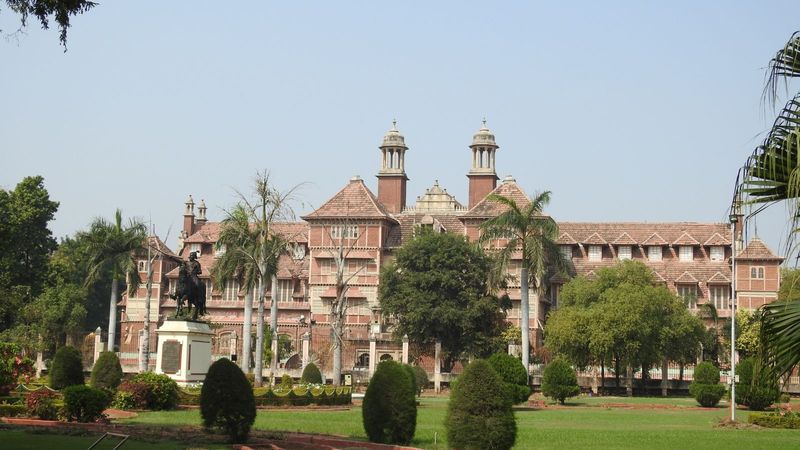Laxmi Vilas Palace, said to be four times in size to Buckingham Palace, was built in the 19th century, by the Gaekwads, a distinguished Maratha family and the rulers of the state of Baroda at the time. The Gaekwads, owner of the Laxmi Vilas Palace, are still a notable family in Gujarat and continue to live in the palace. The Laxmi Vilas Palace is also said to be one of the, if not the biggest private residences, thanks to its sprawling size. A true symbol of the Indian Maharaja's opulence and other royalty were famously known for, the palace is a breathtaking historical monument. The owner of the Laxmi Vilas Palace, Maharaja Sayajirao Gaekwad III commissioned a British architect to make the most magnificent palace that would captivate everyone’s attention. The royal family of Baroda consider the palace a crown jewel among their rich legacy, as it rightfully is.
The history of Laxmi Vilas Palace is as captivating as the palace itself. Built over twelve years, this impressive palace was completed in 1890. This was when the British were facing strong resistance from Indian kings, who wanted to prevent British interference in kingdom matters. But, Maharaja Sayajirao Gaekwad III never sought to fight against the British forces, instead taking their assistance to develop his kingdom and even commissioning a reputed British architect, Major Charles Mant, to oversee the building of his palace. Laxmi Vilas Palace, built over an area of at least five hundred acres, is said to at one time possess a zoo, a school, a small railway network and so much more, telling the rich tales of the history of Laxmi Vilas Palace. The palace continues to possess several other buildings on its grounds as part of its vast complex, all of which are now open to the public.
The architectural style of the Laxmi Vilas Palace is of an Indo-Saracenic style. This style is a riveting mix of Hindu, Mughal and Gothic architectural elements. Thus, the palace is adorned with minarets, arches and domes throughout its expanse. It is also said about the Laxmi Niwas Palace that this palace hosts a spectacular collection of Raja Ravi Verma paintings and many other artefacts, vintage and modern, from all over the world, adorning the interiors.
A beautifully maintained interior style that consists of the most dazzling chandeliers, and montages, the famous artwork elevates the beauty of the palace. Belgian stained glass windows, Venetian chandeliers, mosaics, sculptures, and an array of diverse elements were used to give the palace its unique touch. The gardens of the palace were specially designed and curated by the very same botanist who designed the popular Kew Botanical Gardens in London. A palm courtyard complete with an elaborate fountain was also created to further make every detail about the Laxmi Niwas Palace as exquisite as possible.
Laxmi Niwas Palace has many areas that attract special attention. The Maharaja spared no cost to make his palace the stuff of dreams, making people speechless even after centuries. For example, the Darbar Hall of the palace is a beautiful yet commanding room where presently every important event, musical concerts, etc. is held. The Darbar Hall is adorned with the throne of Maharaja Sayajirao Gaekwad III, adding a majestic touch to the interiors of the room. The beautiful stained glass windows are a glorious extension of Gothic architecture. The armoury collection sporting an impressive collection of swords and other weapons used during the Maharaja’s time takes a place of pride, along with an eclectic mix of marble, bronze and terracotta sculptures.
The palace also has three beautiful entrances, with one grand foyer exclusively used by Maharaja Sayajirao Gaekwad. The chandeliers brightened up the area, marble and bronze sculptures, royal arches and ornate work on the walls made the magnificent foyer suitable to the Maharaja's royal standards. The Hathi Hall is also an alluring vision, with its chandeliers, arches and exquisite work on the walls, pillars and arches. Other charming rooms include the Silver Room, and the Gulabi Room, which was the personal living room of Maharani Chimnabai II.
The complex of the Laxmi Vilas Palace not only houses the sprawling palace that still serves as the private residence of the royal family of Baroda, but it also houses a host of other equally charming buildings. Buildings such as the Maharaja Fateh Singh Museum, which was a private school for the Maharaja’s children, Moti Baug Palace, a golf course, MotiBaug Cricket Ground, banquets, an indoor teak-floored tennis court and more make up the impressive complete grounds of the Laxmi Niwas Palace, making this historical monument nothing short of an impressively vast statement of India’s royal past.

The palace is also in proximity to several other places that are a must-visit while in the city, such as the Surya Mandir, Keerti Mandir, the Baroda Museum and Picture Gallery, etc. Each building is a peak into the culture of the vibrant city of Vadodara making for the perfect way to explore. Make sure to explore the palace and all the other complex buildings and all the buildings near the palace to make your holiday a memorable experience.
Timings: 9:30 am – 5 pm (Closed on Mondays as well as all public holidays)
Entry fee: Rs 150 (Palace fees) and Rs 60 (museum fees)
Best time to visit: October – February


_1707237485249_thumb_1200.jpeg?w=3840&q=75)

